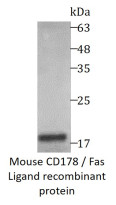ARG70401
Mouse CD178 / Fas Ligand recombinant protein (Active) (His-tagged, N-ter)
Mouse CD178 / Fas Ligand recombinant protein (Active) (His-tagged, N-ter) for SDS-PAGE
Overview
| Product Description | E. coli expressed, His-tagged (N-ter) Active Mouse CD178 / Fas Ligand recombinant protein |
|---|---|
| Tested Application | SDS-PAGE |
| Target Name | CD178 / Fas Ligand |
| Species | Mouse |
| A.A. Sequence | Gln128 - Leu279 |
| Expression System | E. coli |
| Protein Full Name | Tumor necrosis factor ligand superfamily member 6 |
| Activity | Active |
| Activity Note | Determined by its ability to induce apoptosis in Jurkat cells. The ED50 for this effect is < 1 μg /mL. |
| Alternate Names | FASLG; Fas Ligand; APT1LG1; TNFSF6; CD178; FasL; Tumor Necrosis Factor Ligand Superfamily Member 6; Fas Ligand (TNF Superfamily, Member 6); Apoptosis Antigen Ligand; Fas Antigen Ligand; CD95 Ligand; CD95-L; CD95L; APTL; FASL; Tumor Necrosis Factor (Ligand) Superfamily, Member 6; Mutant Tumor Necrosis Factor Family Member 6; Apoptosis (APO-1) Antigen Ligand 1; Tumor Necrosis Factor Ligand 1A; CD178 Antigen; ALPS1B; TNLG1A |
Properties
| Form | Powder |
|---|---|
| Purification Note | Endotoxin level is less than 0.1 EU/µg of the protein, as determined by the LAL test. |
| Purity | > 98% (by SDS-PAGE) |
| Buffer | PBS (pH 8.0) |
| Reconstitution | It is recommended to reconstitute the lyophilized protein in sterile water to a concentration not less than 200 μg/mL and incubate the stock solution for at least 20 min at room temperature to make sure the protein is dissolved completely. |
| Storage Instruction | For long term, lyophilized protein should be stored at -20°C or -80°C. After reconstitution, aliquot and store at -20°C or -80°C for up to one month. Storage in frost free freezers is not recommended. Avoid repeated freeze/thaw cycles. Suggest spin the vial prior to opening. |
| Note | For laboratory research only, not for drug, diagnostic or other use. |
Bioinformation
| Gene Symbol | FASLG |
|---|---|
| Gene Full Name | Fas Ligand |
| Background | This gene is a member of the tumor necrosis factor superfamily. The primary function of the encoded transmembrane protein is the induction of apoptosis triggered by binding to FAS. The FAS/FASLG signaling pathway is essential for immune system regulation, including activation-induced cell death (AICD) of T cells and cytotoxic T lymphocyte induced cell death. It has also been implicated in the progression of several cancers. Defects in this gene may be related to some cases of systemic lupus erythematosus (SLE). Alternatively spliced transcript variants have been described. |
| Function | Involved in cytotoxic T-cell-mediated apoptosis, natural killer cell-mediated apoptosis and in T-cell development. |
| Cellular Localization | Cell membrane, Cytoplasmic vesicle, Lysosome, Membrane, Nucleus, Secreted |
| PTM | Disulfide bond, Glycoprotein, Ubl conjugation |
Images (1) Click the Picture to Zoom In






